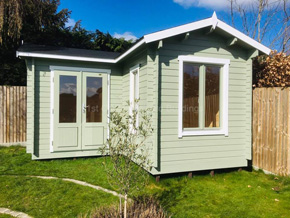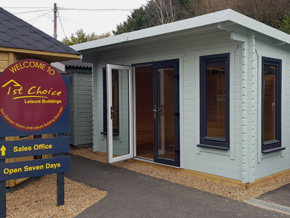Log cabins have become an increasingly popular choice for residential gardens with homeowners seeking a unique blend of rustic charm and modern functionality to find the best log cabin to suit their needs.
Whether you’re looking for a peaceful retreat from the busyness of daily life, a functional, productive space for a home office, or a versatile outdoor space for a bar or garden shed, selecting the best log cabin for your purposes requires careful consideration of several key factors.
To help you figure out what you want and need, we’ve put together a guide to help walk you through the essential aspects you need to consider when choosing the best log cabin to meet your needs, ensuring that you make an informed decision and get plenty of satisfaction out of your investment.
1. Define Your Purpose
If you’re considering investing in a garden cabin, make sure you fully understand its intended use.
Are you looking for a guest room, a garden office, a studio for your hobbies or a peaceful summer house?
Whatever you need it for, we can make it happen. But you must know what you want, as these things will significantly influence your log cabin’s size, design, and other significant features.
Here are some of the main types of log cabins you can choose from:
- Guest Room: A log cabin is a great option for a guest room as it can be nice and private. If this is what you’re going for, you must prioritise electricity, heating, and possibly even plumbing for a small bathroom and kitchenette to ensure comfort for your guests.
- Garden Office: For those working remotely and needing a garden office, things like electricity and insulation should be prioritised to make sure you’ve created a comfortable working environment all year round.
- Hobby Studio: A log cabin is a great space to dedicate to hobbies like writing, painting, or woodworking. This may require specific modifications like extra storage space, soundproofing or enhanced lighting.
- Summerhouse: If your main goal is to use it for relaxation and leisure, it’ll be a good idea to ensure your cabin is spacious and airy and has large windows to let in plenty of natural light.
2. Consider the Size You Need
Log cabins are available in various sizes, and selecting the right size depends on multiple factors – most importantly, the available space in your garden and your intended use of the cabin.
Here are some tips for determining the appropriate size of your log cabin:
- Interior Space Needs: Think about the interior layout and how much space you’re going to need for whatever you’re using the cabin for. If the cabin will serve multiple purposes, like both a gym and an office, you may need additional square footage.
- Measure Your Space: Before you go ahead and order a building, measure the area where you’re planning on installing your cabin. Ensure that there’s adequate space for the cabin and movement around it and any additional landscaping you may decide to include.
- Future Considerations: Make sure you consider not only your current needs but your future needs too. For instance, if your family is growing, opting for a larger cabin may be a good idea.
3. Select the Right Timber
Choosing the timber your log cabin is made of is essential as it affects the cabin’s durability, insulation and aesthetic appeal.
Common types of wood used for the best log cabins include:
- Spruce: Spruce is a fairly common choice as it’s known for its smooth finish and strength. It can be a bit more expensive than a budget option but requires very little maintenance.
- Cedar: Cedar is normally considered a fairly premium option, as it’s a bit more expensive. It offers natural resistance to rot and insects, great durability, and a beautiful, rich colour. It’s very unusual to find this in the UK
- Pine: Pine is known for its availability and affordability. It offers great insulation but may require more maintenance over time.
- Larch: Larch is a super durable type of wood, and it has a natural resistance to moisture and decay. It’s an excellent choice for outdoor structures in wetter climates.
The other thing to remember when choosing types of timber is the thickness of the logs. The thicker the logs, the better the insulation and durability, making the structure ideal for year-round use.
4. Focus on Weatherproofing and Insulation
Weatherproofing and insulation are crucial to using your log cabin comfortably throughout the year. A well-insulated cabin will remain warm in the winter and cool in the summer so that you can save money on loads of artificial heating and air conditioning.
- Wall Thickness: Look for, or build, a cabin with thick, high-quality logs, as these provide great insulation values. Log thickness of at least 44mm is recommended for year-round use.
- Double Glazing: Windows are another important consideration. Double-glazed windows provide better insulation than single-glazed windows, which can help maintain the stability of the interior temperature. It can also help reduce noise. All 1st Choice’s Trentan and Humber have double glazing as standard.
- Roof and Floor Insulation: The roof and floor are two of the most common areas where heat can escape. Ensure these areas are well insulated, especially if the cabin will be used as a living space, like a guest room or an office.
- Weatherproofing: Make sure your cabin is properly treated with a top-quality preservative or stain to protect the wood from moisture, insects and UV rays. Regular maintenance, like reapplying stains or treatments, will significantly extend your cabin’s life.
5. Select the Style of Roof
There are a few different types of styles of roofs to choose from, and your decision will impact not only your cabin’s functionality but its aesthetic appeal too.
Here are a few options you can choose from:
- Pent Roof: Single-sloped roof that offers a modern look and is great for smaller spaces. It’s suitable for storage or smaller garden offices.
- Apex Roof: A traditional peaked room that provides good headroom and sheds water effectively. An apex room is ideal for offices or general living space cabins.
- Flat Roof: This is a more contemporary option that is ideal for minimalists. While it doesn’t shed well or efficiently like other roofs, it can still be effective if you ensure proper drainage.
- Hipped Roof: A hipped roof slopes on all sides, making it perfect for awful weather. It is a more expensive option, but it offers not only great protection against the elements but a unique aesthetic, too.
6. Try Go for Customisable Options
One thing that people love about log cabins is that they can be customised according to your preferences and specific needs.
When picking out your log cabin, consider these options:
- Decking and Verandas: Adding a deck, patio or veranda can extend your living space outdoors and give you the perfect spot for relaxing or entertaining during the summer.
- Windows and Doors: Go for additional windows or larger doors to increase natural light and improve ventilation.
- Exterior Finishes: You can choose from a plethora of different exterior finishes, including coloured paints, wood stains or cladding to match your cabin to your garden or home aesthetics.
- Interior Layout: Some suppliers offer customisable interior layouts which will allow you to create separate rooms or open-plan spaces as required.
7. Consider the Foundation
A good, solid foundation is, arguably, one of the most important parts of building a log cabin, contributing to its longevity and stability.
These are a few different types of foundation types you can choose from based on the soil type in your garden and the size of your cabin:
- Concrete Slab: A concrete slab is easily the most durable and stable foundation for a log cabin, making it suitable for larger cabins or those intended for use all year round.
- Timber Frame: A timber frame foundation is ideal for smaller, more lightweight cabins. It’s easier to install and can be adjusted to uneven ground, but it may require more maintenance over time.
- Paving Slabs: If you’re working with a smaller cabin, paving slabs can be the most budget-friendly option. They provide a level surface with good drainage but are probably less durable than a concrete slab.
- Ground Screws: Ground screws are an eco-friendly, modern option that offers flexibility and ease of installation. They’re ideal for sites with difficult terrain or where minimal disruption to the landscape is desired.
8. Key Budget Considerations
Ensure you properly consider exactly how much money you have to spend on your log cabin, but the cheapest option isn’t always best.
Here are some budget tips:
- Look out for hidden or unexpected costs.
- Cheaper cabins may save you money upfront, but they could cost more to maintain in the long run.
- Consider financing options to help spread out the cost.
9. Contact 1st Choice Leisure Buildings
Choosing a trusted, reputable supplier is the most essential part of ensuring that you receive a high-quality product and reliable customer service.
1sr Choice Leisure Buildings will be able to do everything for you from beginning to end. We offer full service, high-quality materials and exceptional expertise at competitive, transparent prices.
Contact 1st Choice Leisure Buildings today for a quote on the best log cabin options available to you.











